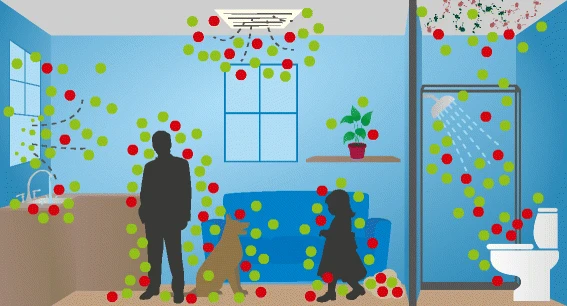Aerosols accumulate over time in enclosed spaces
Aerosols vs. droplets
Dr. Linsey Marr - Aerosols & Transmission of Respiratory Viruses 101
Dr. Kimberly Prather on reducing community transmission of COVID-19
The Quest of the Virosols
Indoor Air - DW Report
Supercomputer shows humidity effect on COVID-19
Community-Based Aerosol Transmission Of COVID-19 and HVAC Systems
Let’s talk about transmission of respiratory infectious diseases
Aerosols movement shown with lasers
The White House: Let’s Clear The Air On COVID
Source: https://www.whitehouse.gov/ostp/news-updates/2022/03/23/lets-clear-the-air-on-covid
“The most common way COVID-19 is transmitted from one person to another is through tiny airborne particles of the virus hanging in indoor air for minutes or hours after an infected person has been there. While there are various strategies for avoiding breathing that air – from remote work to masking – we can and should talk more about how to make indoor environments safer by filtering or cleaning air.
In fact, research shows changing the air in a room multiple times an hour with filtered or clean outdoor air – using a window fan, by using higher MERV filters in an Heating, Ventilation, and Air Conditioning (HVAC) system, using portable air cleaning devices, and even just opening a window – can reduce the risk of COVID-19 transmission – with studies showing five air changes an hour reduce transmission risk by 50 percent. 1,2 And, improving indoor air has benefits beyond COVID-19: it will reduce the risk of getting the flu, a common cold, or other diseases spread by air, and lead to better overall health outcomes.”
Your Personal Microbial Cloud
When you breathe in, you inhale a cloud of gas and liquid droplets. When you breathe out, you release a cloud of gas and liquid droplets. This is natural, it doesn’t matter how healthy you are or whether you or someone near you has COVID-19, this ebb and flow is happening all of the time. Invisible particles float in the air, like smoke, forming clouds around us all, simply breathing and talking, and increase over time spent in enclosed or poorly ventilated spaces.

Airborne microbiota are everywhere. Everyday, we are bombarded with bacteria, viruses and fungi in the air around us. Bioaerosols come from people in the room with you, or even from people who were in the room earlier in the day. Microbes are disbursed into the air from our skin, hair, noses, and mouths. We all spread microbes wherever we go, including through our exhalations.
What is the microbiome?
We humans are mostly microbes, over 100 trillion of them in/on each of us. The microbiome is the genetic material of all the microbes – bacteria, fungi, protozoa and viruses – that live on and inside the human body. The number of genes in all the microbes in one person’s microbiome is 200 times the number of genes in the human genome. Microbes outnumber human cells, and although they occupy less space, your microbiome weigh as much as five pounds. The bacteria in the microbiome are essential for life, as much as any organ in the human body, and help digest our food, regulate our immune system, protect against other microbes that cause disease, produce neurotransmitters, and vitamins needed for blood coagulation. The discovery of ever more important roles for human microbiome by scientists is accelerating.

What does the microbiome have to do with COVID-19?
If you are enclosed in an indoor space, bus, train, or plane, you will be breathing in air exhaled by others. When the atmosphere is humid, there is less chance of breathing in harmful microbes, because the water molecules attach to the particles causing them to become too heavy to remain airborne. When the atmosphere is dry, airborne microbes remain airborne.
Recent research confirms that an occupied space is microbially distinct from an unoccupied one, and has demonstrated that individuals release their own personalized microbial cloud.
There is a very entrenched idea that viruses mostly spread through larger droplets rather than aerosols. The idea dates back to the 1930s, when scientists were upending outdated notions that disease was caused by “bad air,” or miasma, long before we knew about the human microbiome. In fact, the microbiome was not generally recognized to exist until the late 1990s.
Aerosol Spread
- We know that 96%, 99% and 94% of particles emitted while coughing, sneezing and speaking, respectively, are < 100 µm in size
- We know that small liquid particles up to 100 µm in size can float in the air for minutes to hours before settling on surfaces and are thus, by definition, aerosols
- We now accept that masks are beneficial for both source control and personal protection
- We understand that COVID-19 is an overdispersed pathogen, not unlike Mycobacterium tuberculosis (TB), which also spreads through aerosols. Both pathogens propagate in clusters and through superspreading events, where one person infects many others. In the case of COVID-19, 10-20% of individuals may be responsible for 80% of transmission.
- We have seen a clear increased risk of transmission in crowded, poorly ventilated spaces, and from activities that increase the production of aerosols (speaking, singing, shouting, heavy breathing)
- Consistent with the fragile enveloped structure of coronaviruses, fomite transmission is not considered to be the primary mechanism of spread
- COVID-19 genetic material has been harvested in ventilation systems and ferret studies have demonstrated COVID-19 infections through the aerosol route
- We now recognize that ventilation is an important factor in preventing the spread of COVID-19 indoors
from Appendix of Ventilation not Ventilators (Doctors, Scientists & Engineers call on Ontario to address airborne spread of COVID-19 in open letter, November 24th, 2020)




